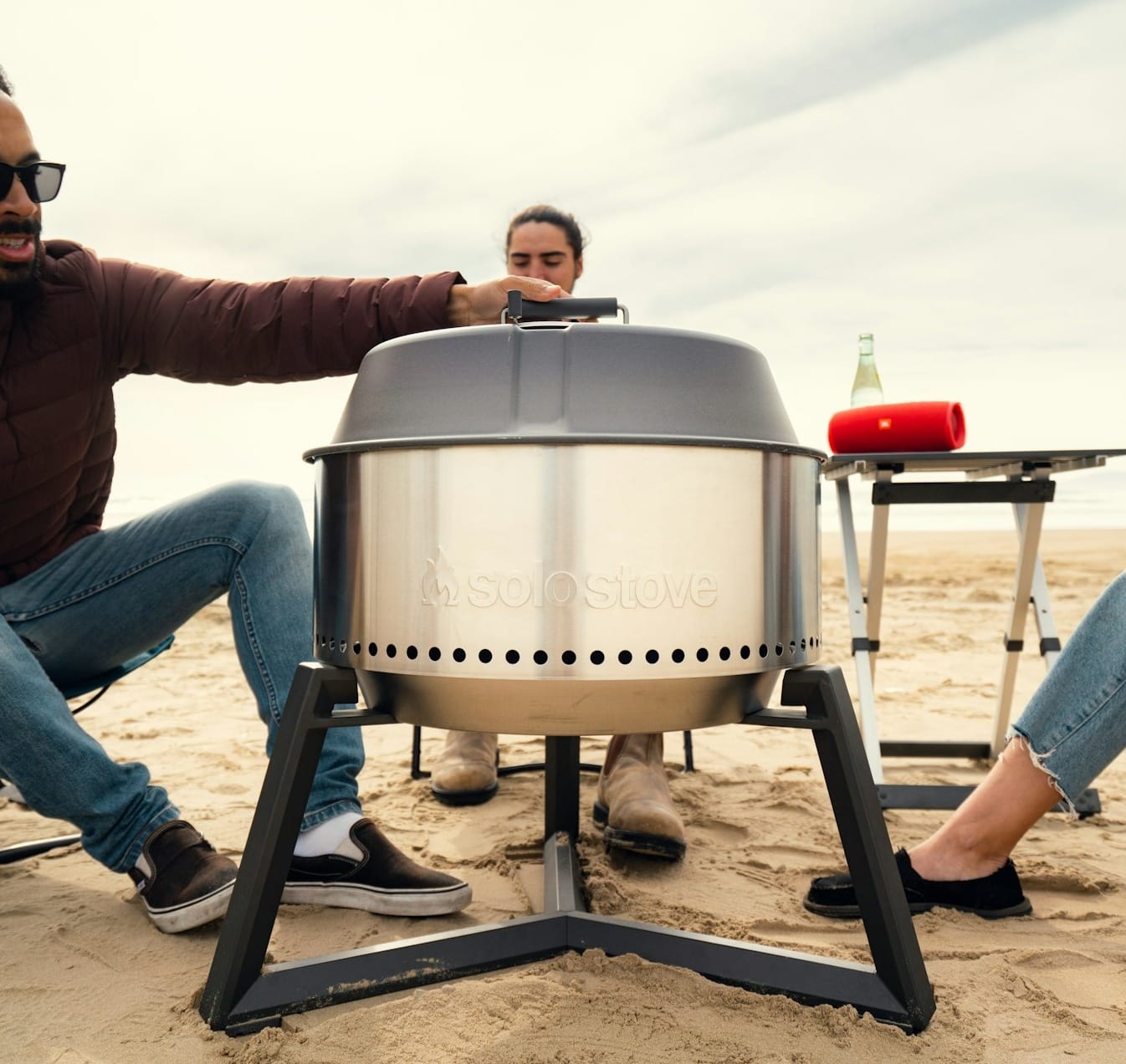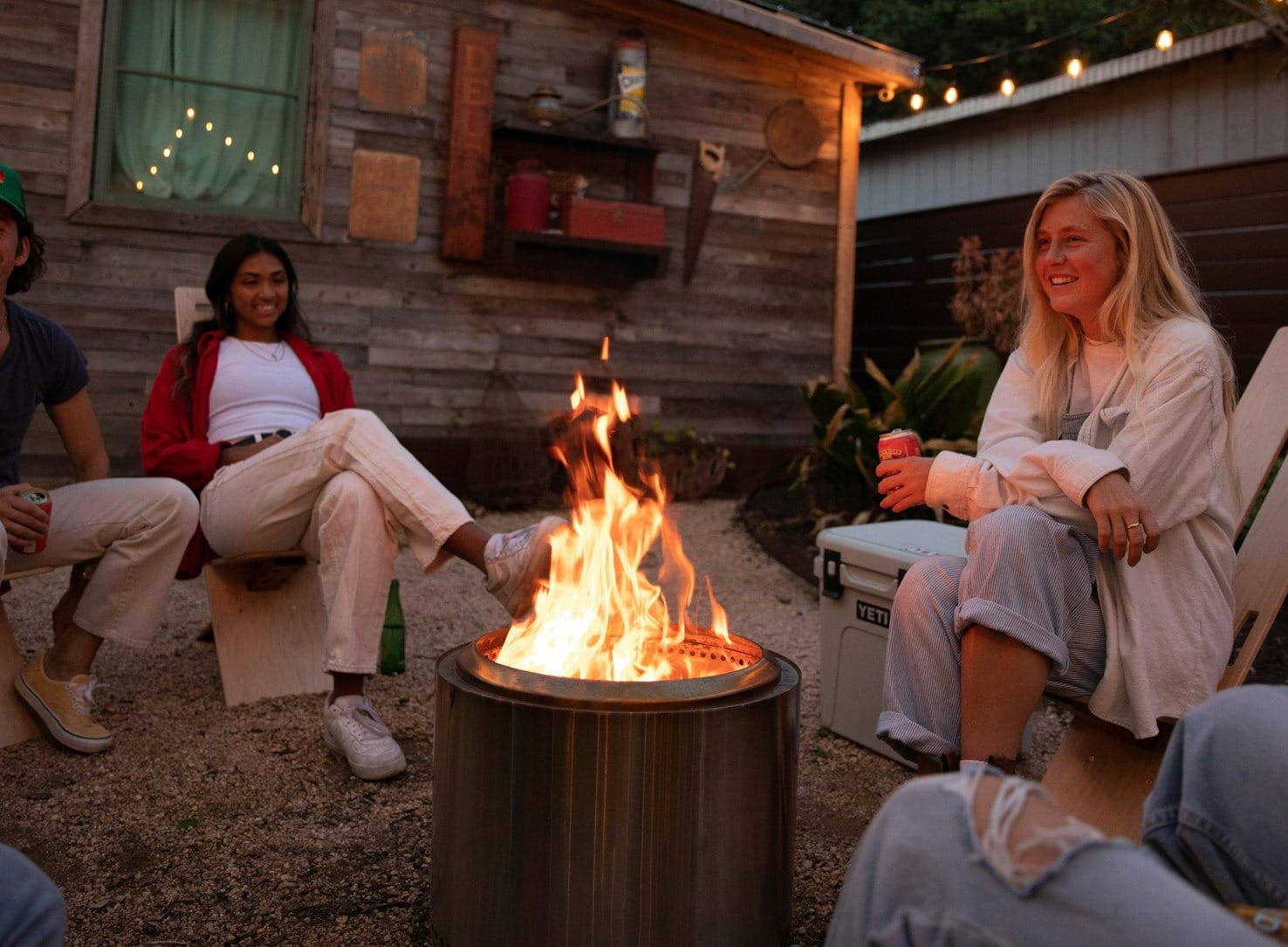Solo Stove: From Campers to Innovators

For years, the campfire space saw very little innovation. When it came to creating the perfect campfire experience, the options were limited to either dealing with the hassle of smoky, inefficient wood-burning stoves or stick with clunky, portable propane burners. But in 2011, two brothers from Texas saw an opportunity to rethink the campfire experience entirely. Solo Stove, founded by Jeff and Spencer Jan, would change the way people gathered around fires forever by offering a simple, efficient, and smokeless stove designed to elevate outdoor gatherings.
The idea behind Solo Stove wasn’t born in a corporate boardroom but around a campfire – or rather, a frustrating one. Jeff and Spencer, both outdoor enthusiasts, were tired of choking on smoke and struggling to get their campfires going. There had to be a better way. The breakthrough came when they designed a double-walled stove that optimized airflow to produce a cleaner, hotter flame with minimal smoke. The result was a portable, efficient stove that not only made outdoor cooking easier but also enhanced the experience of gathering around a fire.
Solo Stove’s innovation wasn’t just about creating another campfire accessory; it was about improving the experience of something as iconic as a campfire. The product was a sleek, minimalist design made of high-quality stainless steel, and it offered a new way to enjoy outdoor fires, whether you were in the wilderness or in your own backyard. By using the principles of airflow and combustion, Solo Stove created a smokeless fire pit that allowed people to gather, cook, and enjoy nature without the typical smoke and hassle of traditional campfires.
The journey from this simple innovation to a billion-dollar company wasn’t immediate. The Jan brothers launched the company in 2011, focusing primarily on direct-to-consumer (DTC) sales. They built their business online, bypassing traditional retail channels and offering their product directly to customers through their website. This approach not only allowed them to maintain higher profit margins but also gave them the opportunity to connect directly with their customers, gathering feedback that would shape future products.
In the early stages, Solo Stove had to focus heavily on creating brand awareness in an industry that was used to traditional outdoor gear. They used content marketing and community engagement to spread the word, particularly leveraging the power of social media. By sharing their product on platforms like Instagram, they showcased their product in real-life settings, demonstrating how Solo Stove was changing the way people enjoyed outdoor fires. The focus on organic content and user-generated content helped build a strong community around the brand, creating word-of-mouth marketing that helped the brand go viral.

The brothers also understood that their customers weren’t just looking for a product; they were looking for a premium experience. Solo Stove’s sleek, minimalist design was carefully crafted to appeal to outdoor enjoyers who valued both functionality and aesthetic. The emphasis on creating a high-quality product that stood out visually and performed well helped Solo Stove establish itself as a premium brand in the outdoor space.
The Solo Stove team knew they had a compelling product and just had to get the word out. The use of grassroots marketing and word-of-mouth spread their message. As more and more customers discovered Solo Stove, the product's popularity grew, and the company gained traction with outdoor enjoyers and those looking for a better way to enjoy their backyard gatherings. In the early years, the team was small, and every task – from design to fulfillment – was handled internally. This lean approach helped keep costs down, but it also required a scrappy, do-it-yourself mentality that would help the company thrive in its early stages.
Grassroots Marketing
Grassroots marketing refers to a strategy that focuses on building a product's reputation and awareness through organic and local efforts, often relying on community-based engagement, word-of-mouth, and low-cost strategies rather than large-scale, expensive advertising campaigns. This type of marketing is designed to leverage authenticity and personal connection to generate buzz and foster brand loyalty.
For Solo Stove, grassroots marketing likely played a significant role in their early growth, as they focused on getting their product into the hands of consumers who were passionate about outdoor experiences. These early users were then encouraged to share their positive experiences via social media, word-of-mouth, and even customer-generated content, such as photos and videos of their Solo Stove products in action. This helped the brand organically build a loyal customer base and expand awareness through recommendations from real users, rather than relying on traditional advertising methods.
As Solo Stove’s popularity soared, the team began to see the potential to scale beyond the camping community. In 2016, they launched the Solo Stove Bonfire, a larger model designed for backyard use. This product was a game-changer, bringing Solo Stove’s innovative, smokeless technology to a whole new market. The Bonfire became a hit, and its success marked a turning point for the company, helping Solo Stove transition from a niche camping brand to a more mainstream product for a wide range of consumers.
Value Proposition
Increasing your value proposition is one of the most effective strategies for achieving business success. A strong value proposition goes beyond just explaining what a product does; it highlights how the product improves customers' lives or solves a problem. When a company enhances its value proposition, it creates a more meaningful connection with its customers, addressing their needs and desires in a way that stands out from the competition.
For example, Solo Stove’s introduction of the Bonfire is a great example of how expanding a product offering can increase value. Initially, Solo Stove's smokeless fire pits were designed for camping enthusiasts, offering a cleaner and more efficient way to enjoy a fire. By introducing the Bonfire, a larger and more accessible fire pit, Solo Stove increased its value proposition by appealing not just to outdoor adventurers but also to backyard owners and families looking for a premium fire experience at home.
When companies like Solo Stove find ways to increase the value they offer, they can connect with a broader audience and drive growth. This is because a stronger value proposition not only addresses existing customer needs but also anticipates new ones, creating greater satisfaction and long-term success.
Solo Stove’s success is not just the result of its innovative products but also its ability to create a strong brand identity. The company’s minimalist design, focus on quality, and dedication to a better campfire experience resonated with consumers, and the brand quickly became synonymous with premium outdoor products. Their grassroots marketing strategy helped build an engaged community around the brand. Solo Stove positioned itself not just as a product but as part of a larger lifestyle. The company’s emphasis on authenticity and the joy of outdoor living helped it foster a loyal following that extended beyond the product itself.
This was also a time when the brand began to offer accessories like fire pits, covers, and other outdoor lifestyle products. With the Bonfire, Solo Stove was able to tap into a new demographic, expanding its customer base and solidifying its position as a leader in the outdoor lifestyle space. The move from camping gear to a backyard-focused product was a strategic shift that paid off. But with growth came the need to scale. Solo Stove had proven the concept with its original products, and now it needed to handle increased demand.

The company continued to grow through direct-to-consumer sales, but it also began entering the retail space. By partnering with large retailers, Solo Stove was able to expand its reach and introduce its products to a broader audience. The brand remained committed to its core values of simplicity, quality, and customer satisfaction, all while navigating the complexities of retail partnerships.
In 2021, Solo Stove made a major leap forward when it went public, raising capital to fuel further expansion. The company’s IPO was a significant moment in its journey, as it transformed from a startup to a publicly traded company. With the capital raised through the IPO, Solo Stove could scale its operations, enhance its product offerings, and expand into new markets.
The decision to go public was a reflection of the brand’s strength and growth potential. By going public, Solo Stove secured the financial resources needed to continue its trajectory and expand its footprint. However, going public also meant that the company would face increased scrutiny from investors and analysts. Solo Stove had to balance growth with profitability, ensuring that its core values and commitment to quality were maintained while scaling its operations.
The journey of Solo Stove is a testament to the power of product innovation, branding, and community loyalty. What started as a simple idea to create a better campfire has evolved into a....lets stop right here. You get the gist.
If you've been keeping up with these articles then you're likely recognizing a pattern in these companies, a seemingly obvious blueprint these companies follow as a way to achieve success in almost any industry.
The Blueprint
Every company follows a basic blueprint for success. It starts with making a good product — one that solves a real problem or fulfills a unique need in the market. A product needs to be well-crafted, functional, and something people are willing to pay for. Take Chomps, for example. The founders recognized a gap for healthier, on-the-go protein snacks and created a product with 100% grass-fed beef, setting them apart from competitors and offering a healthier, cleaner alternative. Similarly, Spotify differentiated itself by providing an unmatched user experience.
Next, companies focus on producing the product efficiently and ensuring it meets customer expectations. This means refining manufacturing, meeting regulatory standards, and delivering consistently. For Chomps, this meant sourcing quality beef from trusted ranchers.
The next phase is scaling the product—expanding to meet demand, increasing production, and broadening reach. Chomps expanded into new retail spaces while keeping their product quality intact. Spotify scaled globally, securing licensing deals and refining its technology to manage millions of users worldwide.
While creating, producing, and scaling are essential, successful companies go beyond that. Branding, customer loyalty, and innovation play crucial roles. Chomps built trust with a loyal customer base by focusing on quality ingredients and sustainability. Spotify created a personal connection with users through personalized playlists and recommendations, keeping them engaged. Both companies didn’t just sell products—they built experiences that resonated with customers.
Additionally, smart financial management, understanding market trends, and knowing when to pivot help companies stay ahead. Chomps bootstrapped and grew sustainably, while Spotify’s shift to a freemium model helped it scale rapidly, becoming the dominant platform for music streaming.
So, while a good product → produce → scale method is essential, success comes from delivering consistent value and understanding your audience. And this formula can be applied to any of the companies covered in this newsletter.
Works Cited
- Forbes. "How Solo Stove Went from Backyard Fire Pits to an Outdoor Lifestyle Brand." Forbes, 18 Aug. 2020, www.forbes.com/sites/jeffkauflin/2020/08/18/how-solo-stove-went-from-backyard-fire-pits-to-an-outdoor-lifestyle-brand.
- TechCrunch. "Solo Stove: The Evolution of a Direct-to-Consumer Brand." TechCrunch, 12 Dec. 2019, techcrunch.com/2019/12/12/solo-stove-the-evolution-of-a-direct-to-consumer-brand.
- Business Insider. "Solo Stove: From Garage to IPO." Business Insider, 6 Feb. 2021, www.businessinsider.com/solo-stove-from-garage-to-ipo-2021.
- Outdoor Retailer. "Solo Stove: The Product Innovation Behind the Brand." Outdoor Retailer, 22 May 2021, outdoorretailer.com/solo-stove-the-product-innovation-behind-the-brand.
- Petri.com. "Solo Stove's Acquisition of Oru Kayak and Chubbies: Expanding the Solo Brands Portfolio." Petri.com, 19 Oct. 2021, petri.com/solo-stoves-acquisition-of-oru-kayak-and-chubbies-expanding-the-solo-brands-portfolio.
- The New York Times. "Solo Stove IPO: The Big Bet on Outdoor Living." The New York Times, 9 July 2021, www.nytimes.com/2021/07/09/business/solo-stove-ipo.
- The Verge. "Solo Stove IPO: From Scrappy Startup to Public Offering." The Verge, 8 July 2021, www.theverge.com/2021/7/8/22570524/solo-stove-ipo-public-offering-outdoor-furniture.
- Entrepreneur. "How Solo Stove Built a $1 Billion Brand Without Sacrificing Quality." Entrepreneur, 2 Dec. 2020, www.entrepreneur.com/article/369351.
- Fast Company. "Solo Stove: The Innovation Behind the Smokeless Fire Pit." Fast Company, 18 Oct. 2020, www.fastcompany.com/90536591/solo-stove-the-innovation-behind-the-smokeless-fire-pit.
- Bloomberg. "Solo Stove Plans for Growth After IPO." Bloomberg, 12 Apr. 2021, www.bloomberg.com/news/articles/2021-04-12/solo-stove-plans-for-growth-after-ipo.
- Outdoor Life. "Solo Stove Bonfire: Revolutionizing the Backyard Campfire Experience." Outdoor Life, 3 Jan. 2020, www.outdoorlife.com/solo-stove-bonfire-review.

Member discussion